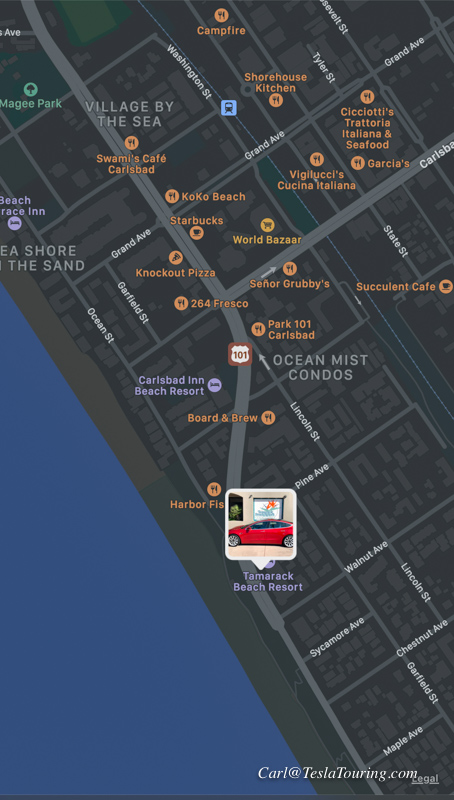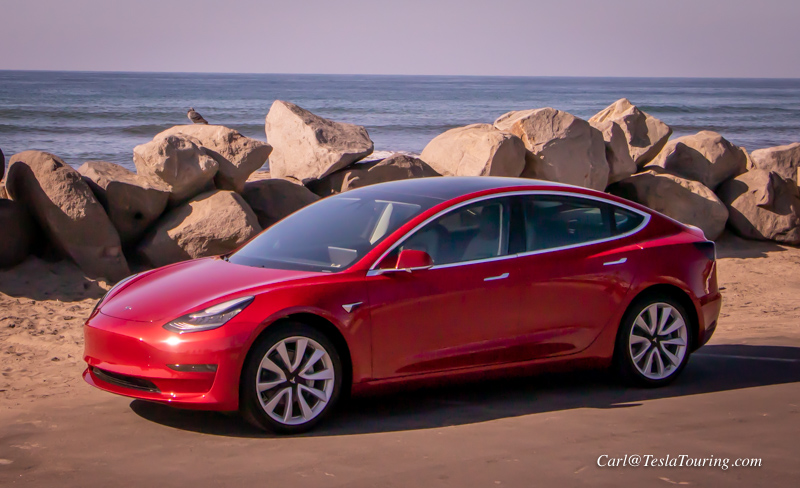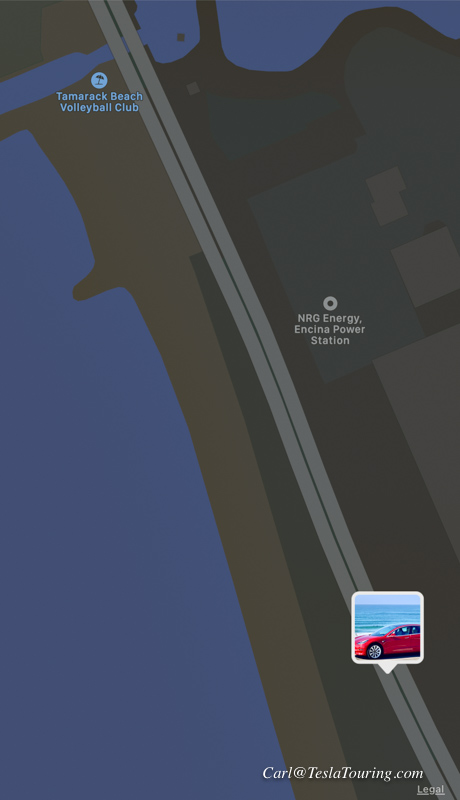Photos in Placentia and Brea, California
Soon after I purchased the Tesla, I took it to a local park for photos.

Two 4-wheel-showing shots

Always use a circular polarizing filter to
eliminate reflections such as the starbursts above. That filter
will also help take out reflections on windshields and windows - even
reflections on water.

Elevated shots
to show the glass roof. I think the 4-wheels-showing shot is used
because the roof of most cars is not interesting. However, this
idea is trumped by convertibles and glass-roofed cars like the Tesla
Model 3 above. Incidentally, the roof is 3 sections of glass and
runs from the hood to mid trunk lid.

A later trip to Lake Tahoe provided more photographic opportunities.

North Shore of Lake Tahoe

East Shore of Lake Tahoe

Southwest side of Lake Tahoe

Truckee, CA, Railroad Museum

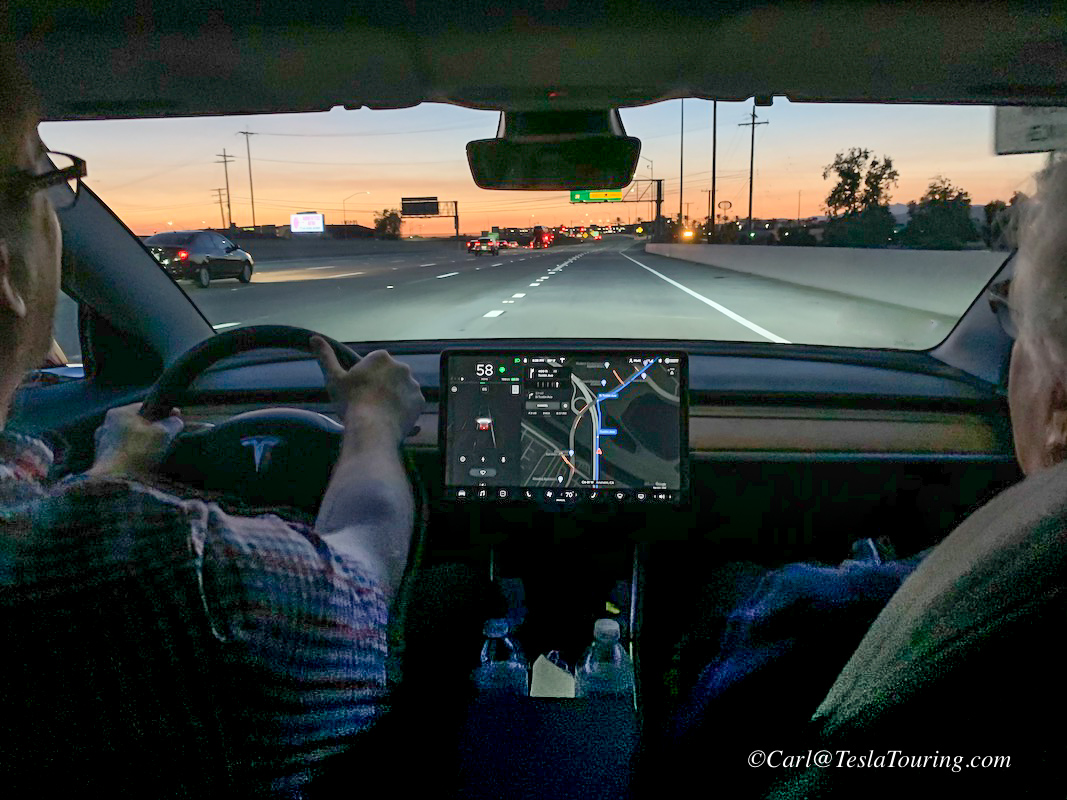
For the best photos of the dash, sit in the back seat and put both
front seats as far back as possible. In this case, I wanted to
show the center screen in the Model 3. Some critics feel it
obstructs the driver's and back seat passenger's view, but you can see
from this post sunset shot that it does not obstruct anyone's
vision. However, if you are the driver, the speed is so
prominently displayed that every passenger can see it and some
passengers might remark if you are silently speeding!

An outside photo of a car is what you see most here. Cars at car
shows or inside arenas at auctions have distracting backgrounds and
lights reflecting off the cars. A studio with controlled
background and lighting is best, but hard to find without great
expense. The image of the front of our Tesla 3 above was taken in
our garage with the sides, top, and bottom views around the car removed
in Lightroom.
From
1998 to 2020, we owned a 1956 Chevy 210 post and took photos of it at
many locations including a cross-country trip following Hwy 50. with
Paul Clifford and his 1957 Chevy convertible.
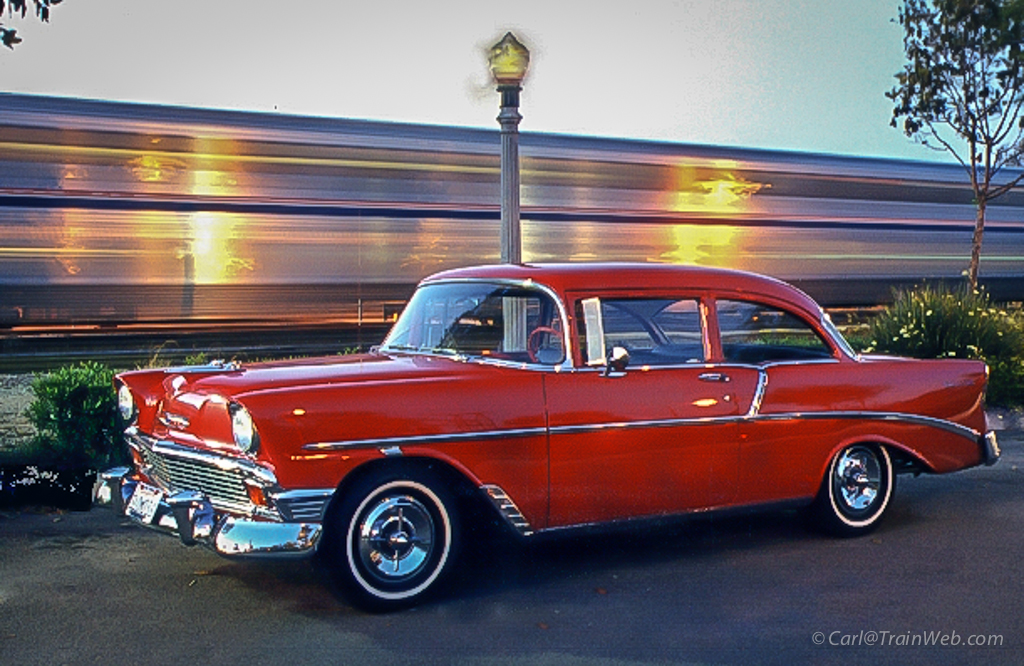
Since I like photographing and writing about trains, especially Amtrak
passenger trains, I placed the Chevy as close to the tracks as I could
get at the Fullerton Amtrak Station, and placed the camera on a
tripod for a long exposure. The background is the Amtrak
Southwest Chief slowly leaving the Fullerton Station. This is my
favorite photo of the Chevy so I used it on one of my business card.

The day we left on our cross-country drive in 2004...should have moved the cars in the driveway.

I had the story of our trip on my back window so wanted it at the
starting point on Hwy. 50, Sacramento, California, and the final
destination 3,073 miles east, Ocean City Maryland.
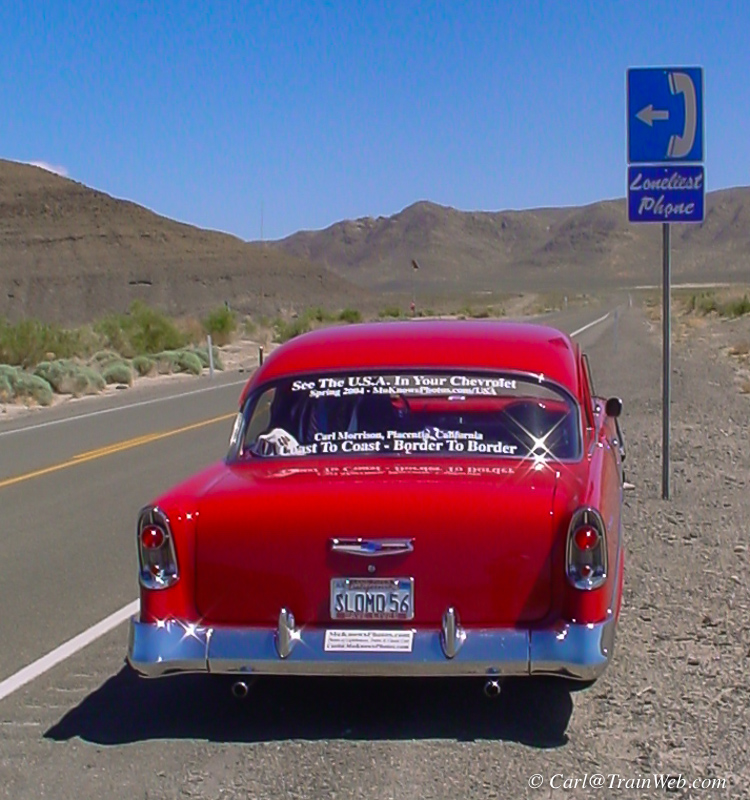
Hwy. 50 in Nevada is called the "Loneliest Road in America" and this
spot in the middle of nowhere was a solar powered phone called the
"Loneliest Phone".
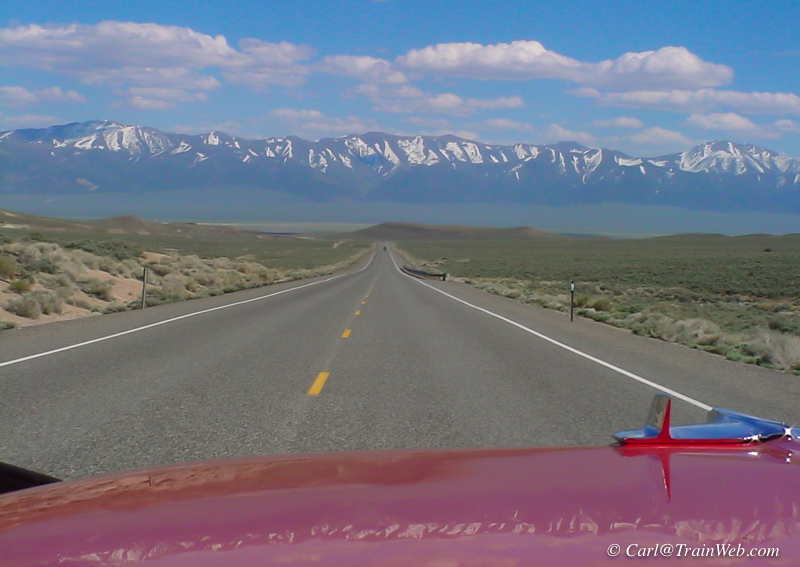
Shoot from within the car, preferably with a nice scene through the windshield.
While driving those 3,073 miles, this was my view from the driver's
seat, following the "bird" on the hood, and the Loneliest Road ahead.
Unfortunately, I could not get in the back seat while driving to get some of the dash in the photo.
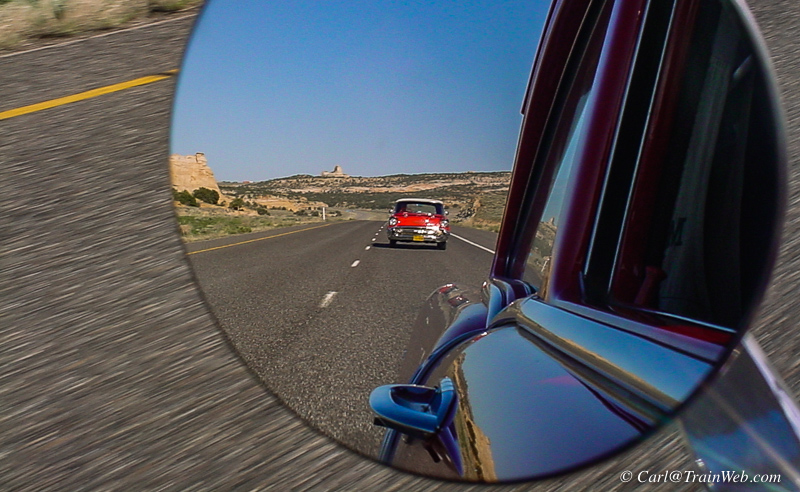
Another familiar scene from the cross-country trip, but perhaps a unique view to some viewers.
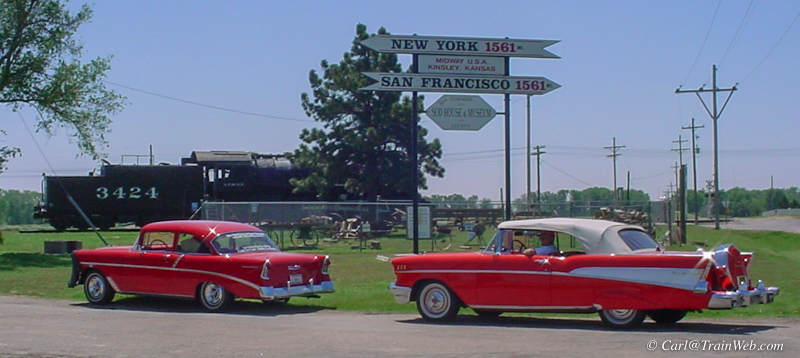
Another landmark along Hwy. 50 is the geographic center of the US - 1,561 miles from New York and 1,561 from San Francisco.
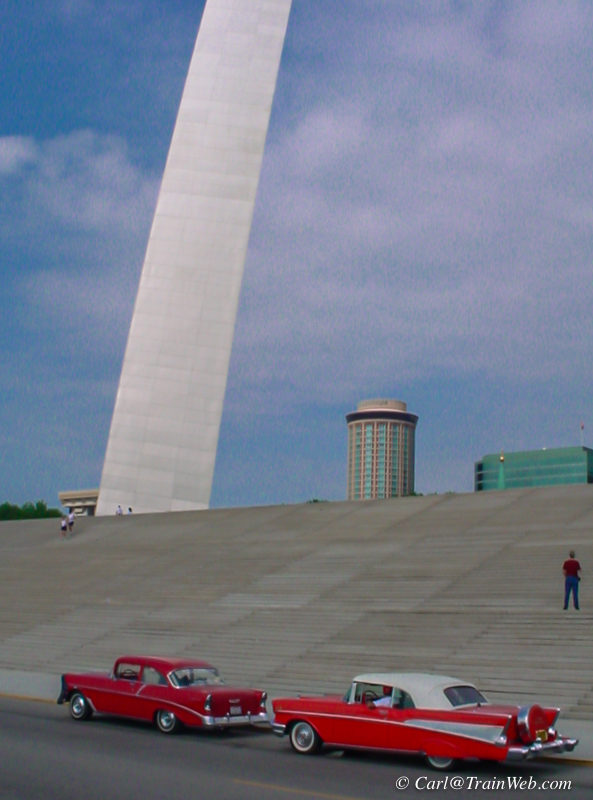
The St. Louis Arch, "Gateway to the West", is to large to have the 2
cars and arch in one photo, so I took this at the base, along the
Mississippi River, showing only the base of the arch.
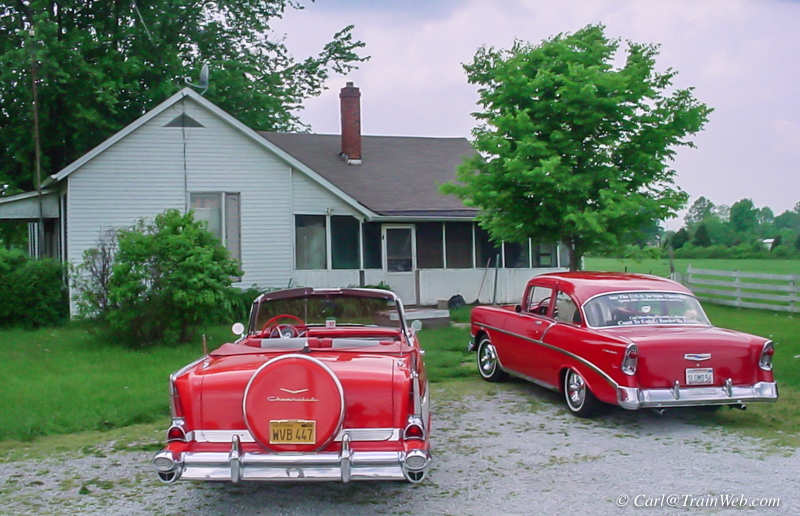
At my birthplace on Hwy. 50 near Hayden, Indiana. I think they
are considering putting up a Hysterical marker here. We drew
quite a crowd f of locals from the highway when they saw two red classic Chevys from California in the driveway.
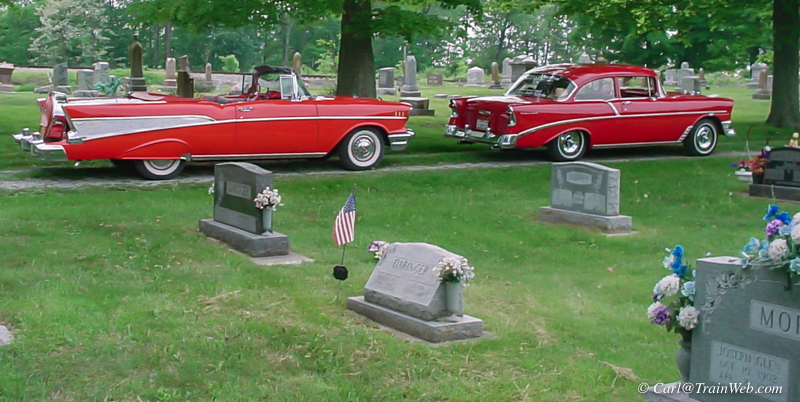
My family had lived near Hayden for 3 generations so my folks' grave, lower right, merited a stop and car photo.

A Sinclair filling station that used to be on Hwy. 50 near Hayden has
been moved and restored at the Museum grounds in town. Another
timely location for photos of cars from the 1950s.
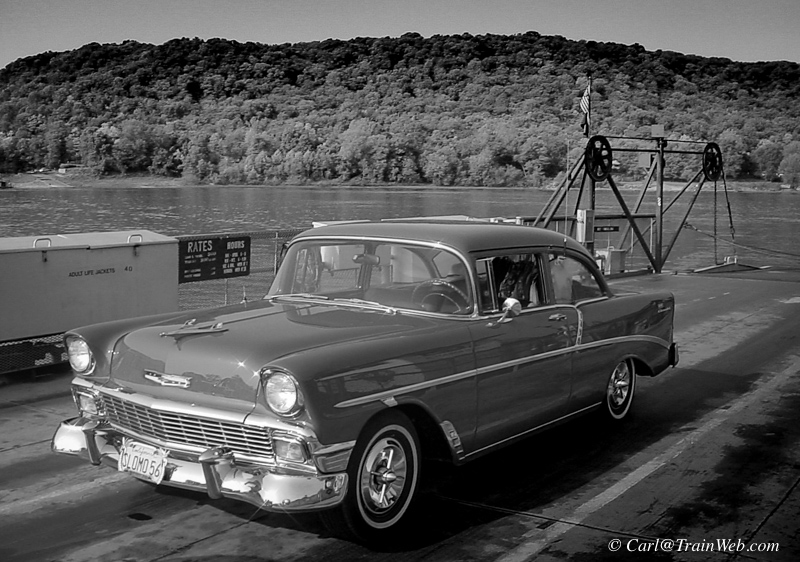
This ferry across the Ohio River, I remember riding when I was a kid in
the 50s. I converted this photo to black and white so it would
look like the day it was purchased and driven home.
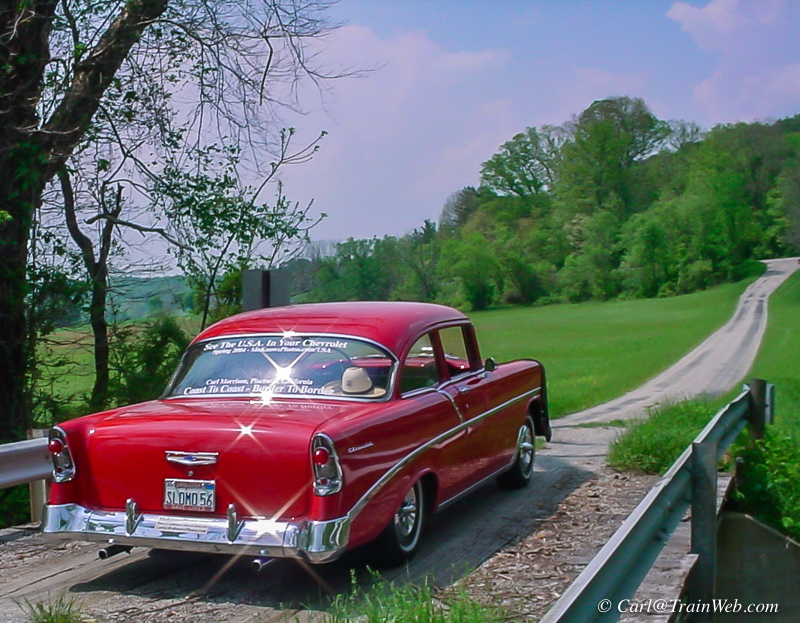
In southern Ohio, we pulled off the road onto a dirt road for a nature
call (No rest stops on this pre-Interstate 2-lane highway.)
I was going to joke that this is what Hwy. 50 looks like in Ohio, but in reality it is a side road, that's 50 at the top right.
My camera in 2004 did not have a polarizing filter, so sunflares abound.

Since Paul's '57 Chevy was behind me and up a little rise, I got a 4-wheels-showing shot.
I feel this could have been a 1957 Chevrolet advertisement in LIFE or
LOOK magazine with the correct year California license plate.

Mail Pouch Tobacco barns are plentiful in the Midwest. This
unused barn in West Virginia was not overgrown with brush so a good
background for our cars along Hwy. 50.
Click the photo above for a black and white version which would be more timely for the cars.
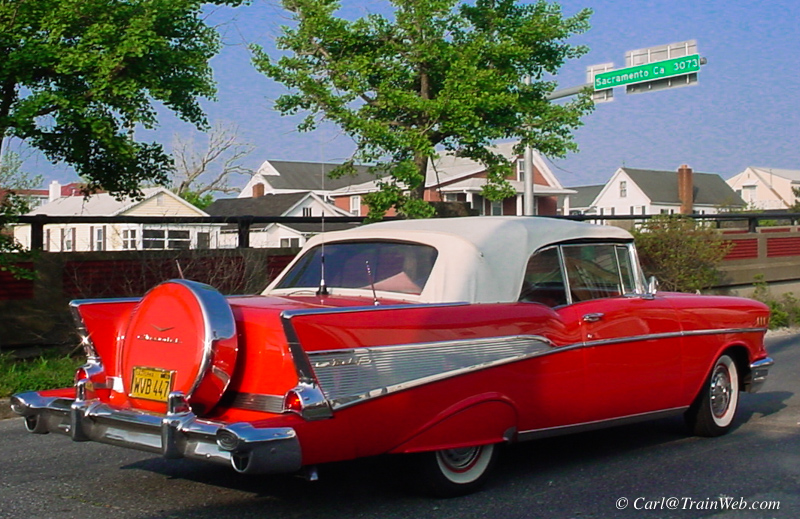
The eastern terminus of Hwy. 50 is Ocean City, Maryland. I
had taken a photo of my '56 in front of the sign in California saying
"Ocean City 3,073 miles". The green sign above Paul's car in
Ocean City as we left says, "Sacramento, Ca 3073"

In March of 2003, I wanted the background of snow covered Mt. San Antonio from a local hilltop in Brea, California.

As mentioned above, car shows are not a good place for individual car
photos. However, while I was lined up to enter a car show in
Yorba Linda, California, in 2018, I was able to keep this photo of the
'56 Chevy by using a program, “ColorBlast!”, which makes the background black and white
and whatever you "uncover" stays the original color.

When I placed the Chevy in an Internet For Sale ad, I needed interior
photos, so took this from the back seat. An outdoor shot would
have left what you see through the windshield distracting in a
photo. I pulled the car up close to the garage doors to eliminate
any distracting elements through the windshield. iPhone 6 plus'
4.15 mm f/2.2 lens plus HDR treatment.
Hot August Nights, a 5,000+ classic car show in Reno and Sparks, Nevada, is a good place to photograph show cars.
A couple of
years ago, we took the '56 Chevy there (with For Sale signs) and
took some photos of it in some scenic and historic spots.

Paul driving our '56 "Slo Mo 56" down Virginia Street to park for the show August, 2019.

An
older "Reno - The Biggest Little City in the World" sign has been
moved to Lake Street. I used it for older car guys who remember
the arch. This was as close as I could get for a shot with the
Chevy in
the foreground. Shooting from lower than eye level made the
sign closer to the top of the car.

This is where I parked for the under-the-old arch photo above. I
thought I might get "Lucky on the Truckee" River and get a good shot of
the car with the river as backdrop. I took this with the camera raised
to arms length above my head from across the 4-lane street to give as
much of a river view as possible.

A
shot of the subject car from another car is another type of automotive
shot, but usually at slow speed on a 4-lane raod, not like this at 70
or so mph. I was in a TeslaTouring.com Model X trailing Paul who
was driving the '56 Chevy and couldn't resist with the Sierras as a
backdrop as we approached Hwy. 395 and Hwy. 14 junction near Inyokern,
California.
The 500 miles we drive from Orange County, California, to Reno, Nevada,
for Hot August Nights is beautiful, desert scenery. It is usually
very hot in August, so I guess the organizers knew that only car guys
would go to Reno in August!
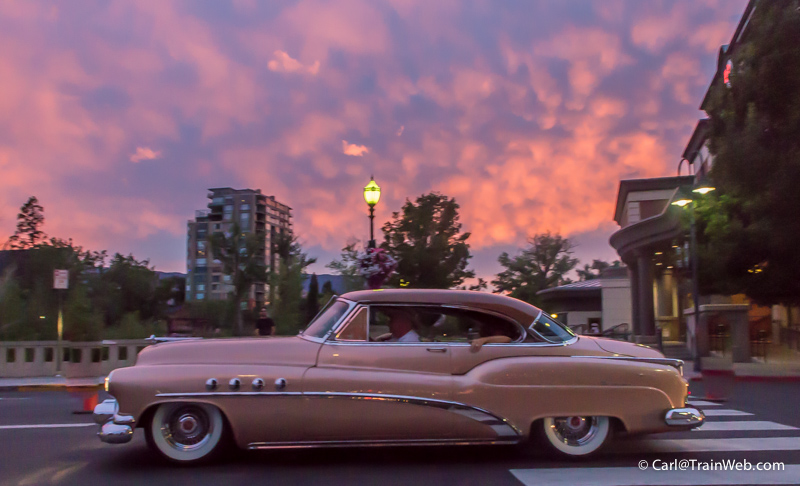
I had mentioned that car shows are not good
places to take photos because of the closeness of the parked cars, or
because of the lights in an arena, but Hot August Nights has a Cruise
each night in both downtown Sparks and Reno. By positioning
ourselves on the bridge over the Truckee River in Reno, if there is a
nice sunset, you can catch cars with the colorful sky as background. Location: Virginia Street, Reno, Nevada.

This guy shows up each year at Hot August and is a challenge to
photograph at the moment he fires off the flames. This is in
downtown Sparks. The camera will expose for the flames so you
need to lighten shadows and decrease highlights in post processing to
get the white truck and flames properly exposed. Location: Victorian Avenue, Sparks, Nevada.

Another outside activity at Hot August Nights is a giant car show
outside each of the large Casino Hotels in Reno and Sparks. Even
though the cars are parked side-by-side, closeups of hood ornaments and
automotive script. As above, many cars have a license plate from
the year the car was built as with this 1939 Buick.

This 1950 Studebaker would never have been built with this color, but
rebuilders make improvements with flashy colors. Also, this car
had its hood up, but a closeup can eliminate any interior cowling
showing.


Left, 1958 Chevy was the first year for dual headlights. Right,
1960 Buick had angled fin rather than vertical fins which
were considered dangerous.

Two-seater convertibles like this 1953 first-year Corvette are easy to
shoot from the back with a raised camera thus cutting out adjacent cars
from the photo.

A closeup of another 1953 Corvette's front light was like no other.


Left, '55 Buick with tons of brightwork (chrome). Right, '56 Chevy with Automotive Script "Bel Air".
Some reflections of nearby cars in the chrome cannot be avoided.

From a low perspective, you can photograph automotive brightwork with the clouds and sky as background.

Even if the car's hood is raised, you can tilt your camera so that this
Pontiac's brightwork of Chief Pontiac looks like he is soaring up into the clouds.
Be careful to use spot metering to get the brightwork in focus rather
than the clouds, or use an extreme f/stop, like f/22 or higher, to keep
both in focus.

Brightwork above, and automotive script Oldsmobile.

Both ladies and airplanes were popular models for brightwork of the 1940s and 50s. This was on a Metropolitan.

Airplane as a model for the brightwork on a 1956 Chevy, with rain to put out the flames.

1936 Hudson Terraplane Sedan Hood Ornament

1959 Chevy, with safer horizontal fins, and a fancy continental kit.

1958 Edsel Pacer also followed the horizontal fin approach.

Some of the cars inside and ready for the auction at the Reno Convention
Center or at the Car Corral at the Livestock Pavilion have outstanding
painting as above and the flag on a '57 Chevy below.
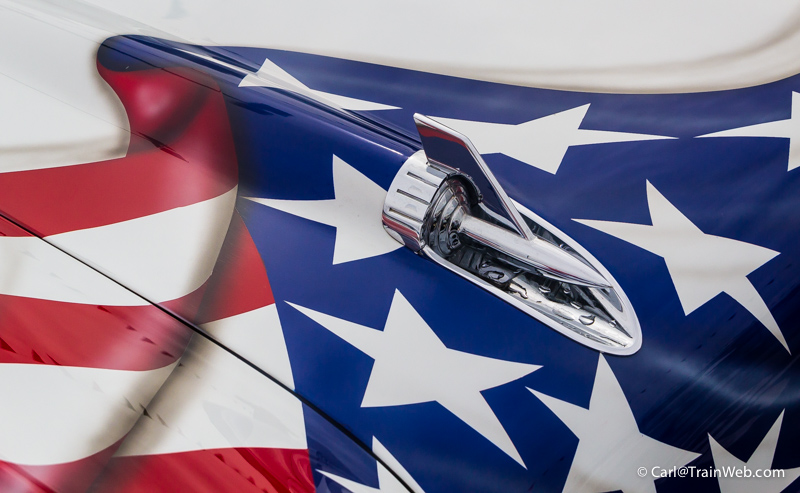

As with this fat-fendered Ford woody, color photography was not often
used back then. Click the image above to see the same woody in black
and white.
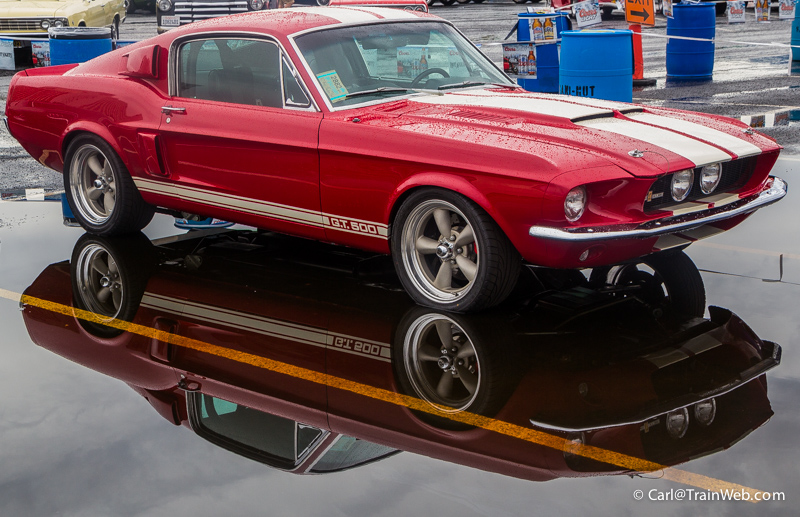
One year at Hot August Nights it rained, covering the highly polished cars with rainwater beads.
I also found a Mustang parked above a puddle, but wondered how to make an interesting image...
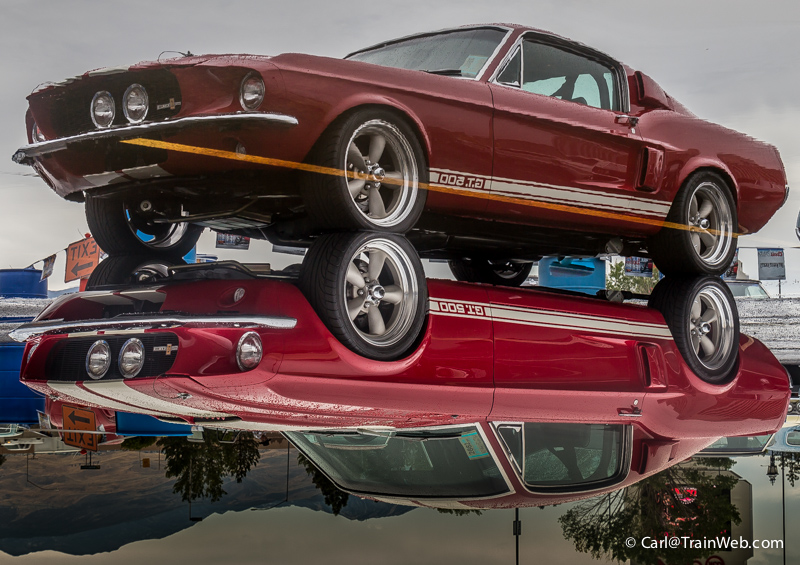
Flipped horizontally and vertically, I found this version more interesting.
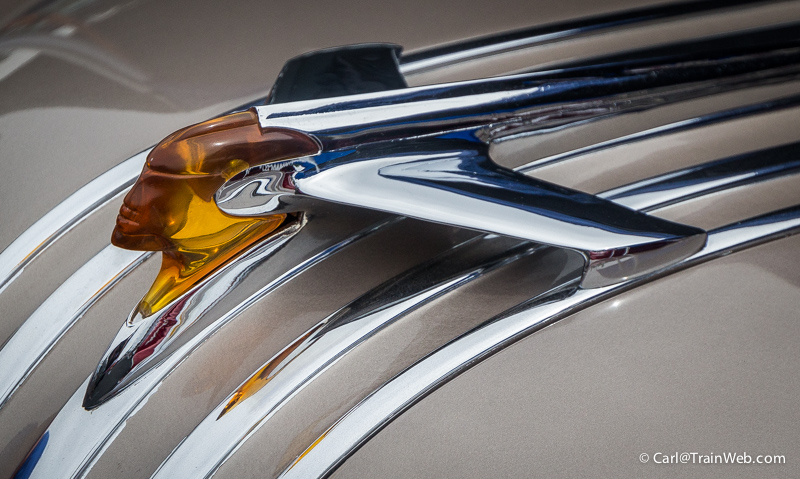
Pontiac brightwork when they had a light in Chief Pontiac's head.

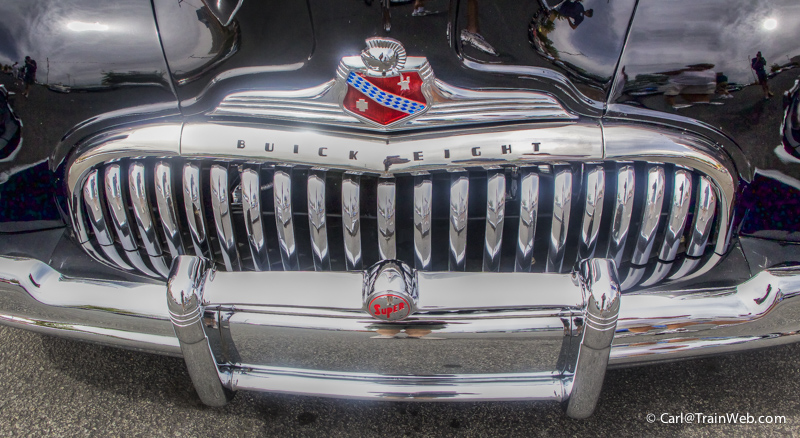
Buick grill reminds me of a baleen whale.

Some
vendors like Jelly Belly have a show car they use in their booth, under
an EZ up, where they hand out small packages of Jelly Bellys.
Petersen's Automotive Museum in Los Angeles has excellent rotating exhibits.
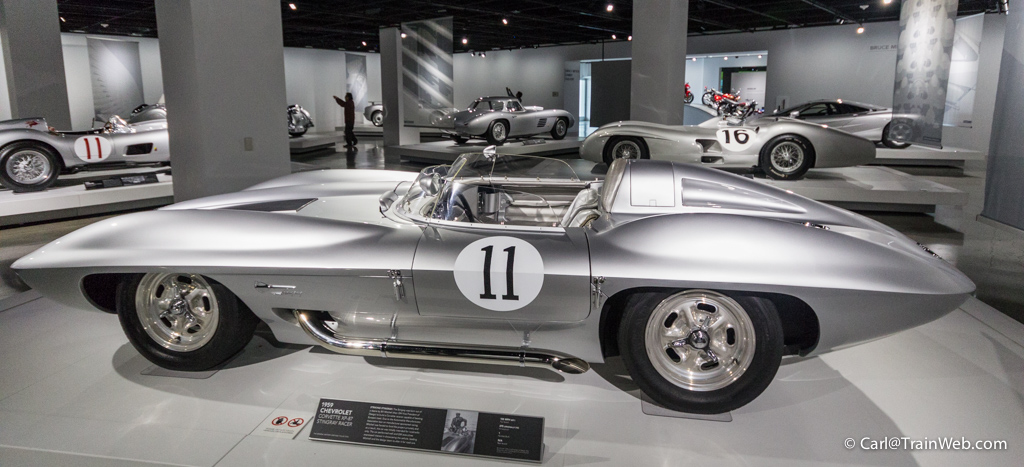
At this Petersen's exhibit, all the exotic sports cars were painted a
matte silver finish eliminating the harsh reflections of the lights.
This image looks like black and white except for the doorway in the back center right.
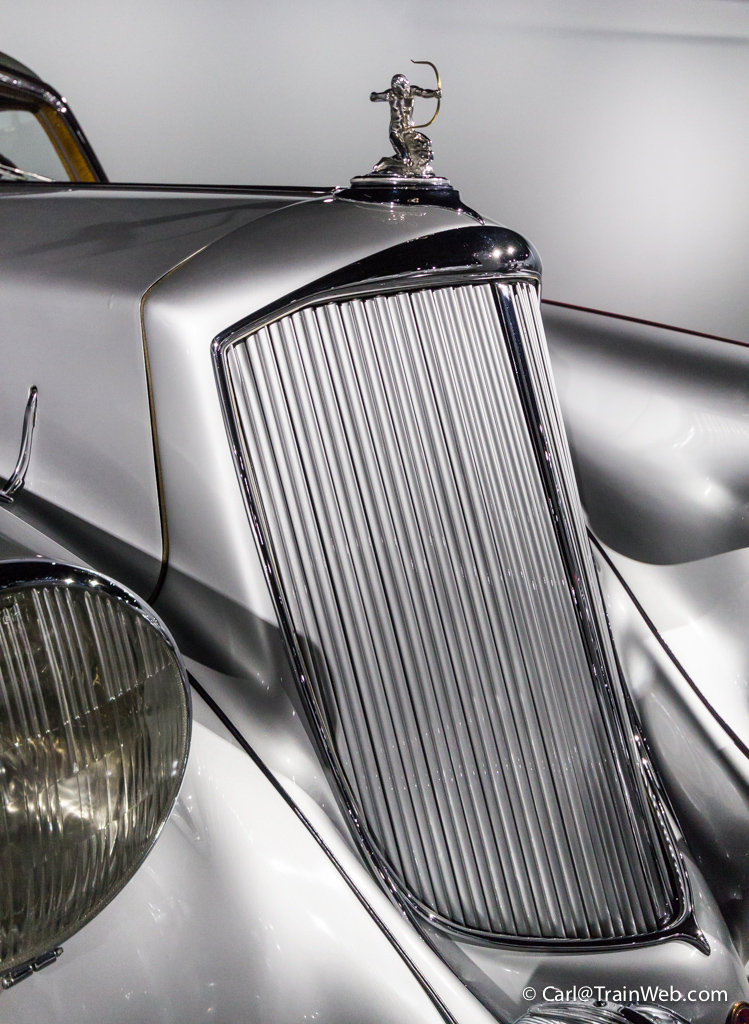

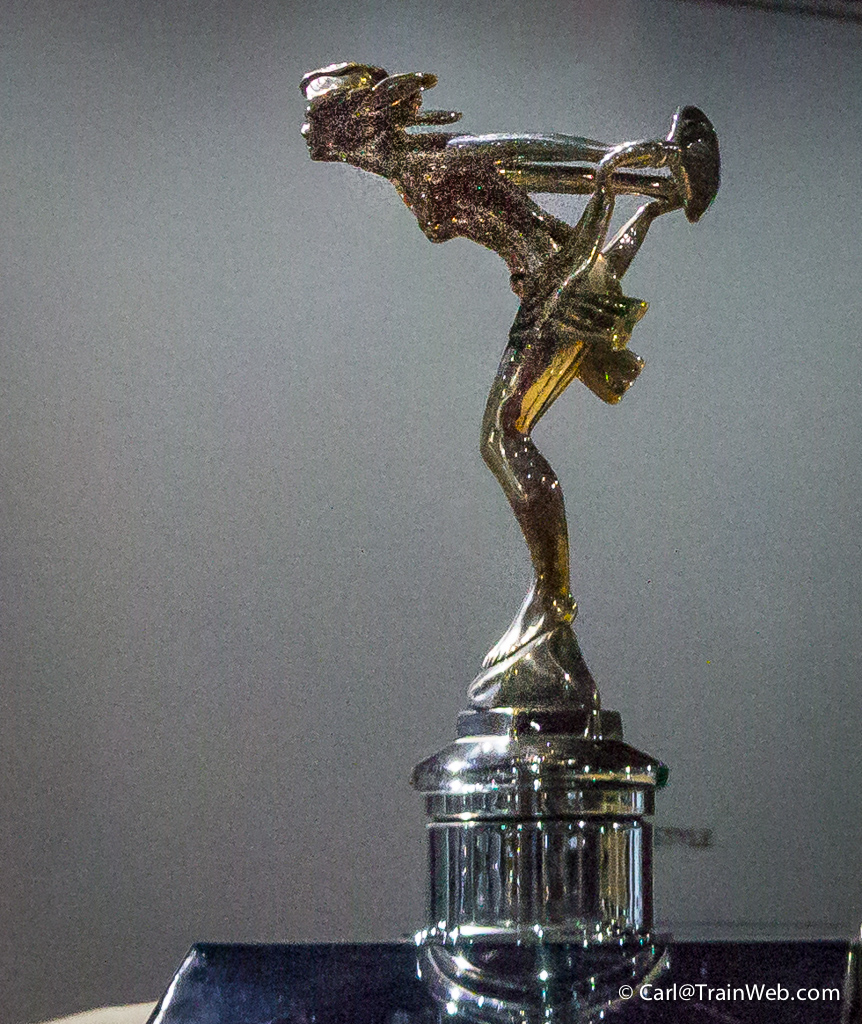 Petersen's exhibits have enough space that the photographer can isolate brightwork of these 30s era cars.
Petersen's exhibits have enough space that the photographer can isolate brightwork of these 30s era cars.

I used the HDR technique on this race car at Petersen's. Click the photo above to see the HDR version.
Auto
races are a good location for photography if you can get close, or have
a telephoto lens. Long Beach, California, has
held several "Long Beach Gran Prixs" for Indy Cars and one E-Prix of
electric open-wheeled race cars in 2016. (That report is at: http://teslatouring.com/carl/LongBeachFormulaERace2016/)
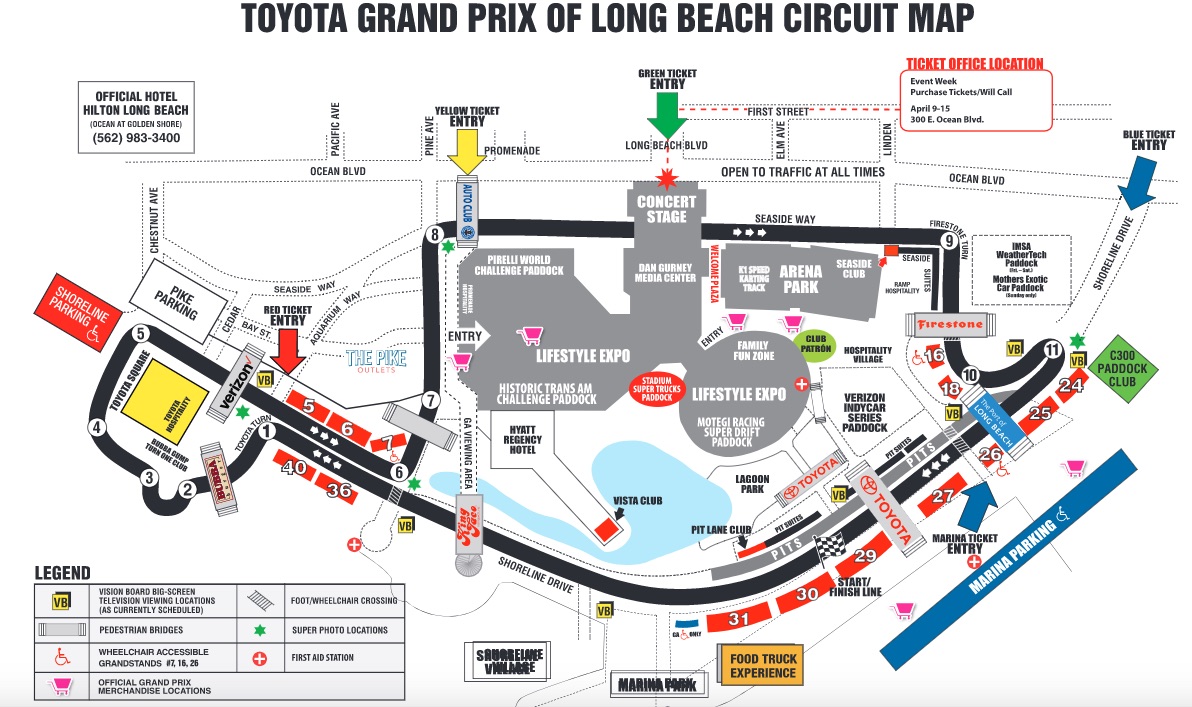
Click the map above for a larger, readable copy.
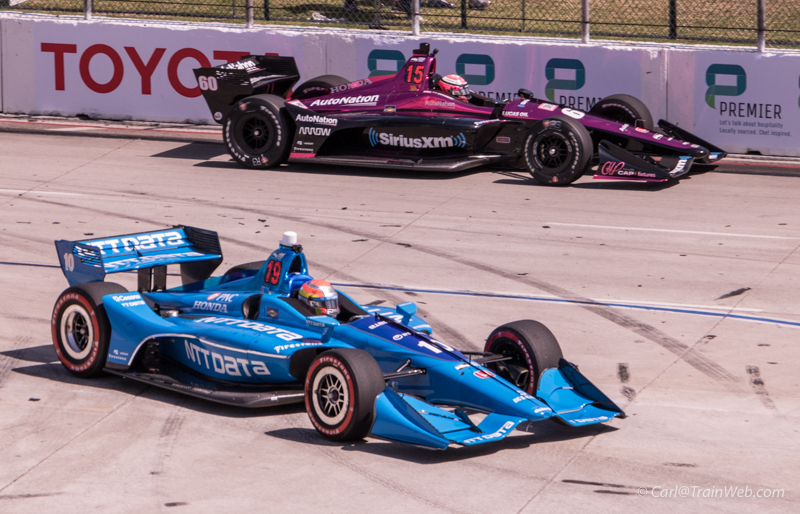
From atop the grandstands on turn 11, you could shoot the cars
starting down the straight reaching 200 mph. (top), or turning into the
pits at about 55 mph. The image of the blue car is better because it is
closer to my elevated position. Notice how you see less of the
far car's body being farther away.
 Heading
down the straight away. Use a fast shutter to freeze the car,
tires, and the writing on the wall as you pan with the car. A slower
shutter speed (1/125), however will blur the wheels and writing on the
wall and foreground showing motion in your photo.
Heading
down the straight away. Use a fast shutter to freeze the car,
tires, and the writing on the wall as you pan with the car. A slower
shutter speed (1/125), however will blur the wheels and writing on the
wall and foreground showing motion in your photo.

The best shots are of the cars as they are pulling into the pits from
the top row of seats on Turn 11 grandstand - accessible on practice
days.
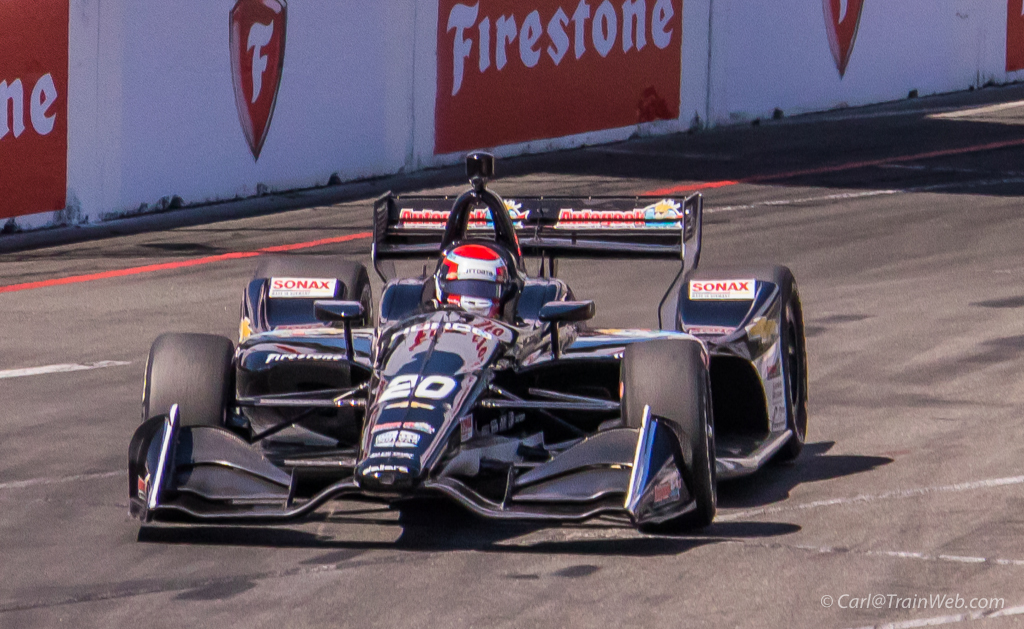
Shooting from Turn 10, toward Turn 9, you can catch the front of the
race cars as they slow and begin their turn into 10. Shooting
from the grand stands on Turn 11, high enough to shoot over the fence,
using a telephoto and later cropping.

Shot from Turn 8, because race fans are on a level above the track, you
can shoot down on the cars after they make the turn during practice and
end up with a photo of all cars out for that practice before you move
to a new location for the second practice. Telephoto used as the
cars passed between the tree tops, then cropped in post processing.

With a Pit Pass, you can get close enough to the cars, with a
telephoto, to photograph the cowling on the car with the driver's name
and flag from his home country.
Historic
automobiles can be found in museums based not wholly on
automobiles. The Lyon Air Museum near the Orange County John Wayne Airport
in California has automobiles among the historic airplanes.

Glass windows on the right eliminated the need for harsh lighting, and a better photo.

The Lyon Museum has a second level that is better for photographing the
large planes, as well as Hitler's 1939 Mercedes-Benz. I left the
motorcycle with side car in the photo since it seems to be from the
same era. Shooting from this level minimized the velvet ropes around
the car and with the top down the interior shows, especially so in this
HDR version.
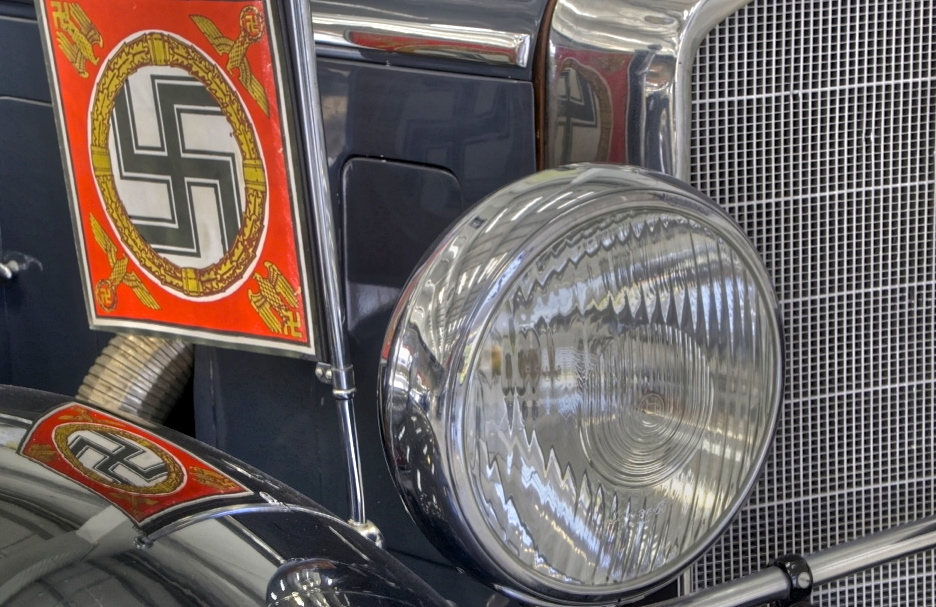
Wondering what part would be the best for a closeup, I chose the flag and reflection in the fender with the whole headlight.
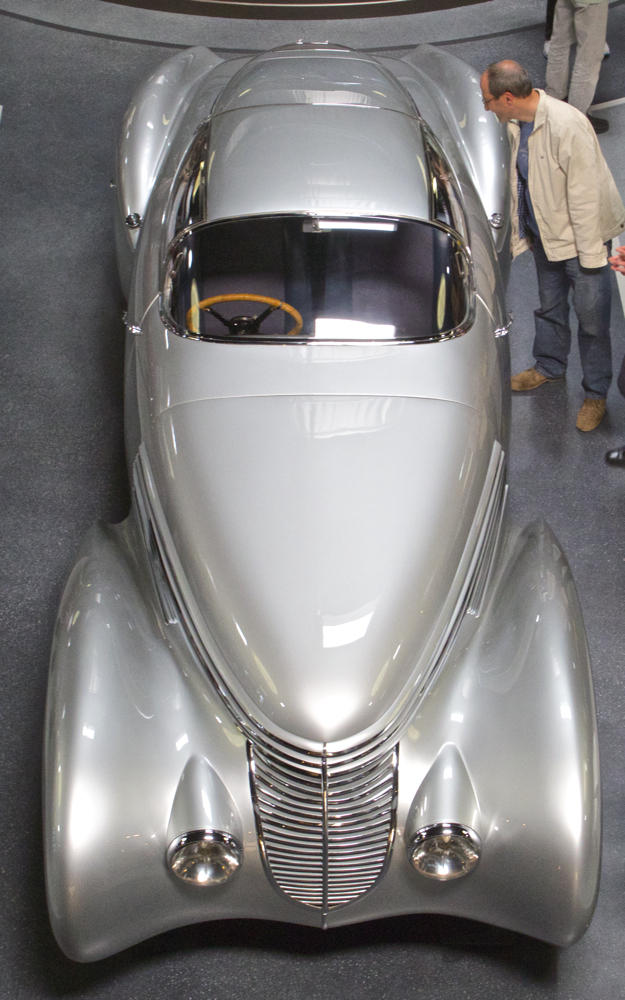

Mullin Automotive Museum, Oxnard, CA
Another balcony view (left) in the Mullin Museum in Oxnard, California,
provided the opportunity for this photo (above left) from above. I did not
wait for the gentleman to leave, using him as a size indicator so
the viewer does not think the car is a model. The gentleman is using proper viewing of show cars technique by not touching or allowing his clothing to touch the car.
On the right, it
looks like a collage, but there was a column I could use as a partial
background with brightwork in the foreground and another classic car
beyond.
Not all photogenic vehicles are "show quality". Some of the best
photos might be taken of abandoned vehicles. I was lucky enough to run
across these in the former railroad town of Cardy, Missouri.
 "Rust in Peace" is what I label most of my old rusty car, truck, and train photos.
"Rust in Peace" is what I label most of my old rusty car, truck, and train photos.
I photographed this find keeping the colorful vines on the left and
"room for the subject to move in the frame" on the right with a
peek-a-boo view of the fall countryside on the right. Perhaps a
little added saturation helped the colorful leaves and goldenrod on the
right.

"Last ride of the Dodge Brothers" was my title for this Dodge
pickup also in Cardy. It had been here for a long time judging from the size of
the tree that had grown up since it was placed here. Again, I think
the colorful surrounding foliage helps the photo.

"Fill 'er Up" at the Laws, California, Railroad Museum which is
an excellent museum of local buildings and trains that have been moved
to this site. With the light from the right, a nice blue sky with
puffy white clouds, and vintage gas pump, my 3/4 shot of the Ford Model
A Coupe turned out OK, don't you think?
Thank you for following my Automotive Photography page to the end!
In case you want to look at prices of a Tesla of any make:
My Referral Number is https://ts.la/carl41979 Just click
the URL to the left to go to the Tesla.com site that will explain the
benefits of using a referral number:

LINKS
[ Top of this page
|
My
Tesla Reports | Tesla Touring
Homepage | My Train Reports ]
I found this useful YouTube Video: 5 AUTOMOTIVE PHOTOGRAPHY TIPS that result in EPIC SHOTS! By: Robb Sutton


